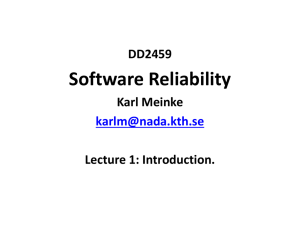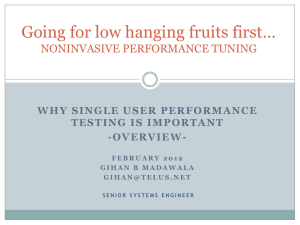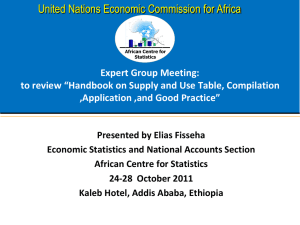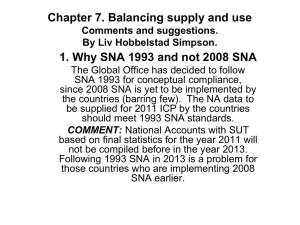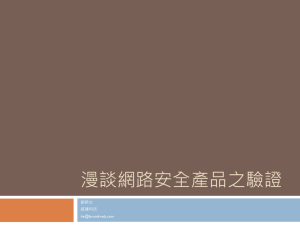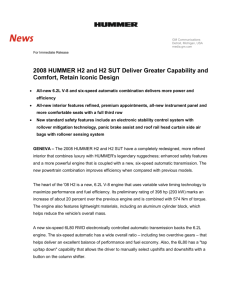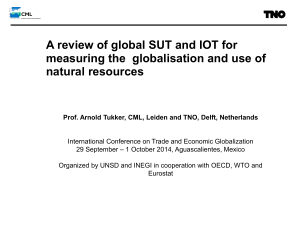Paper - IIOA!
advertisement
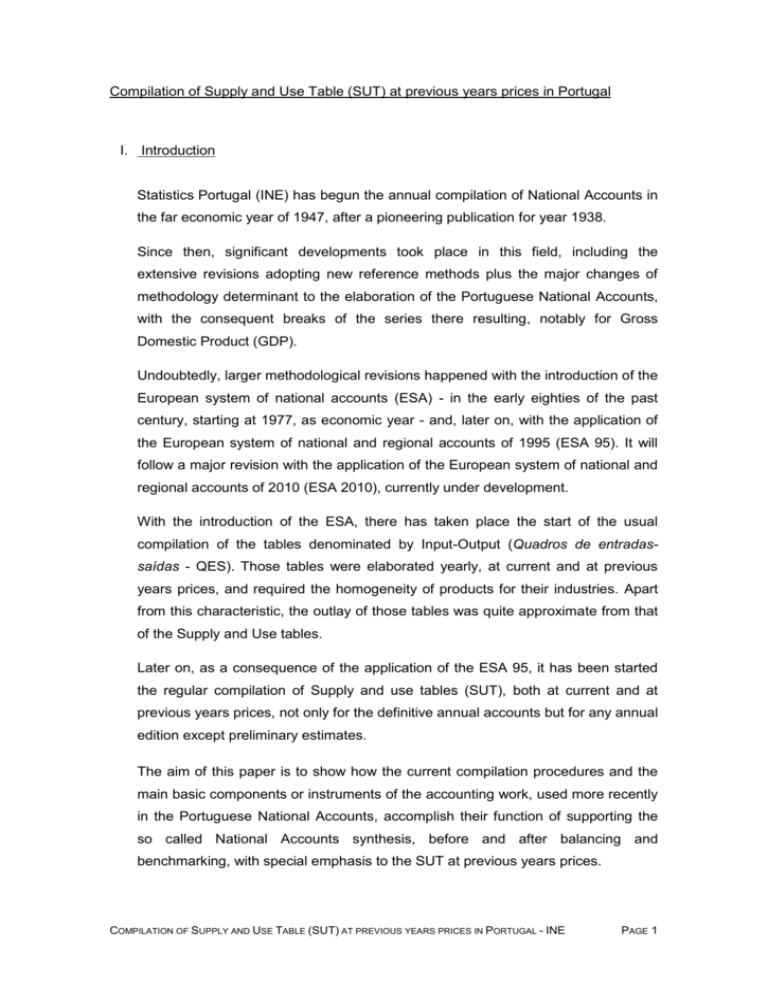
Compilation of Supply and Use Table (SUT) at previous years prices in Portugal I. Introduction Statistics Portugal (INE) has begun the annual compilation of National Accounts in the far economic year of 1947, after a pioneering publication for year 1938. Since then, significant developments took place in this field, including the extensive revisions adopting new reference methods plus the major changes of methodology determinant to the elaboration of the Portuguese National Accounts, with the consequent breaks of the series there resulting, notably for Gross Domestic Product (GDP). Undoubtedly, larger methodological revisions happened with the introduction of the European system of national accounts (ESA) - in the early eighties of the past century, starting at 1977, as economic year - and, later on, with the application of the European system of national and regional accounts of 1995 (ESA 95). It will follow a major revision with the application of the European system of national and regional accounts of 2010 (ESA 2010), currently under development. With the introduction of the ESA, there has taken place the start of the usual compilation of the tables denominated by Input-Output (Quadros de entradassaídas - QES). Those tables were elaborated yearly, at current and at previous years prices, and required the homogeneity of products for their industries. Apart from this characteristic, the outlay of those tables was quite approximate from that of the Supply and Use tables. Later on, as a consequence of the application of the ESA 95, it has been started the regular compilation of Supply and use tables (SUT), both at current and at previous years prices, not only for the definitive annual accounts but for any annual edition except preliminary estimates. The aim of this paper is to show how the current compilation procedures and the main basic components or instruments of the accounting work, used more recently in the Portuguese National Accounts, accomplish their function of supporting the so called National Accounts synthesis, before and after balancing and benchmarking, with special emphasis to the SUT at previous years prices. COMPILATION OF SUPPLY AND USE TABLE (SUT) AT PREVIOUS YEARS PRICES IN PORTUGAL - INE PAGE 1 II. SUT (QRE) in the Portuguese National Accounts framework This section refers to SUT used more recently in the National Accounts (NA) elaborated by INE. i. SUT (QRE) - presentation From 1995 (economic year) up to recent time, based on the SUT framework of the ESA 95 and related bibliography1, INE developed the so called Quadro de Recursos e Empregos (QRE), which is one of the main outputs of the NA as well as a fundamental instrument of the full NA system. QRE are usually described as matrices by industries and products that show in quite a detailed way the yearly output processes and the product transactions occurred during the same time over the national economy. More recently, these matrices started to be compiled in a quite large detail (127 industries by 433 products) and are published at a more aggregated level (82 industries by 88 products or, at least, 38 x 38 industries and products). SUT / QRE have been developed yearly, both in current and at previous year prices, in simultaneous and in an iterative way, as further described. Currently, European Union (EU) requirements in terms of national accounts pass by the accomplishment of the ESA 95 concepts, principles and the production of comparable and consistent data by the EU countries over time, generally since 1995, independently of major revisions of methodology occurred meanwhile. Considering the recommendations of the European Commission about the use of SUT for the compilation of National Accounts, SUT / QRE have been fully used and updated in the “re-construction” of series, including the redress and balancing and benchmarking procedures as well as the updating of the main aggregates of the Portuguese NA there derived. Therefore, QRE performs simultaneously the role of intermediate instrument of compilation and accounting and, also, of output of the concerned accounts, being used previously and after balancing and benchmarking all the information there included. As so, SUT / QRE is one of the fundamental instrument in the compilation as well as output in the Portuguese NA system. By the upper exposed, QRE is a SUT that is fully integrated in the Portuguese NA. 1 ESA 1995; Eurostat Manual of Supply, Use and Input-Output Tables - see Bibliography, in annex. COMPILATION OF SUPPLY AND USE TABLE (SUT) AT PREVIOUS YEARS PRICES IN PORTUGAL - INE PAGE 2 Why this and how far? Let us explain it in the following points. ii. SUT (QRE) - brief description SUT (QRE) consists of a non-symmetrical accounting framework, based on the ESA 95 Input-output system and fully consistent with its concepts, classifications and principles, which combine, namely: two main tables - supply and use tables; two main groups (classifications) of basic elements - products and industries; the whole transactions in products that make part of the production account or the goods and services account plus the distributive transactions related to the generation account of the industries or concerning the valuation of the supply of goods and services in coherence with their uses; totals and balancing items that represent important aggregates of the concerned economy in a certain period of time. Figure 1 Supply and Use Table (QRE), simplified SUPPLY TABLE USE TABLE TOTAL Use at purchasers' prices Use at purchasers' prices (total) Exports Exports Exports (adj.) Gross Capital Formation Gross Capital Formation Gross Capital Formation Final consumption Final consumption Interm ediate consum ption at purchasers' prices Final consumption (adj.) TOTAL Subsidies on products Subsidies on products Industries Total supply at purchasers' prices Taxes on products Taxes on products Imports (CIF) Trade and transport margins Imports Output by product at basic prices Margins Industries Final Uses item s Value added at basic prices Value added at basic pr. / Components Products Valuation item s Supply at purchasers' prices (T) Subsidies on products (T) Taxes on products (T) Total output at basic prices Total Imports (adj.) TOTAL Adjustment items: CIF/FOB; Final cons. Abroad (+/-) Value added at basic prices com ponents Total output at basic prices Figure 1 illustrates, in a simplified form, the SUT (QRE). COMPILATION OF SUPPLY AND USE TABLE (SUT) AT PREVIOUS YEARS PRICES IN PORTUGAL - INE PAGE 3 Using this short representation, other features of this framework may be mentioned, namely: - Supply Table: Supply table shows the domestic supply (output of industries, 127) and the resources from the rest of the world (imports, of goods and of services) by products (433) valuated, respectively, at basic prices and CIF value, more the valuation items adding to the precedent resources, in a detailed form: trade margin, transport margin, non-deductible VAT on products, other taxes on products and subsidies on products (negative signal); - Use Table: Use table presents the full uses by products, either of the industries (intermediate consumption) or the final ones, in a detailed way, more than the above figure: Final consumption of Households, of NPISH and of General government; Gross capital formation, including, GFCF, net acquisition of valuables and Changes of inventories; Exports - of goods and of services. All uses are valued at purchasers’ prices; however, each individual item can be shown separating its basic value from the valuation items: trade margin, transport margin, non-deductible VAT on products, other taxes on products and subsidies on products (symmetric); - Components of value added: the decomposition of value added by industry, basically according to the production factors, is shown in a third table making part of the SUT (QRE), presenting: compensation of employees, taxes on production, subsidies on production (-), consumption of fixed capital and net operating surplus. - Adjustments items: SUT (QRE) includes also the so-called adjustments items, which are necessary to adequate some aggregates to the ESA 95 requirements: Imports by products, firstly included in the supply table at CIF value, needs to be globally transformed in FOB value by its correspondent adjustment items; Final consumption of the households, previously included in the Use table as covering all the consumption occurred in the economic territory of the country, needs to be globally adjusted by two elements: subtracting the domestic purchases by non-residents and adding the direct purchases made in the rest of the world by residents, with the correspondent impact on exports and imports. - Totals and balance items: Totals of most of the transaction of products and of the balance items correspond to relevant aggregates. The total of gross / net value added, as the balance of the production account, and of gross / net operating surplus, as the balance of the generation income account of COMPILATION OF SUPPLY AND USE TABLE (SUT) AT PREVIOUS YEARS PRICES IN PORTUGAL - INE PAGE 4 the industries, are important aggregates resulting from SUT (QRE). GDP is obtained from SUT (QRE) by adding net taxes on products to total GVA. The above referred components of the SUT (QRE) are elaborated and generally available in current and at previous year prices. iii. SUT (QRE) in the NA framework To understand better the role of SUT (QRE) in the NA framework, it is necessary to describe, even briefly, the compilation structure, the basic units and the appropriation of the information from the main sources. The first idea is that the Portuguese NA system is fully integrated in the sense that every resident economic unit acting in the economy is classified in simultaneous in the appropriate institutional sector plus in one (or more) kind of activity; by other side, all its flows and stocks are classified according to its nature (production, distribution, etc.) and function, if appropriated. In all cases, those classifications are identical or similar to the correspondent ones of the ESA 95. Concerning Output (or intermediate consumption) specifically, not only the nature of the transaction shall be classified but also the products produced (or consumed in the production processes). Generally, these data on Output and Intermediate consumption are obtained from several sources, often associated with specific institutional sectors, and that are usually common to other NA outcomes or sub-systems, like quarterly accounts, regional accounts or satellite accounts (agriculture, tourism, health, environment, SAM, etc.) and, furthermost, to the whole economic accounts of the several institutional sectors that constitute the integrated economic accounts table (QCEI, the Portuguese acronym of Quadro de Contas Económicas Integradas). Main NA output tables QCEI and QRE are perfectly consistent and coherent between, since their elaboration is developed in full connection and interactivity. In advance to SUT (QRE) compilation, other important set of tables have to be undertaken: output matrices, intermediate consumption matrices plus supply and use balance tables (ERE, the Portuguese acronym of Equilíbrio Recursos e Empregos), further on explained. The role of SUT (QRE) in the NA framework may be completed by the illustration of the following pictures focused on the overall NA compilation. COMPILATION OF SUPPLY AND USE TABLE (SUT) AT PREVIOUS YEARS PRICES IN PORTUGAL - INE PAGE 5 Figure 2 - Overall NA compilation (I) IES (1) INE´s surveys Output Matrix Product / Industry / Sector / Nature Sector publications General Government bodies accounts Intermediate Consumpt. Matrix Product / Industry / Sector Output - product Intermediate consumption - prod. Taxes & subsidies on products Supply / Uses Balances (EREs) QRE - Supply & Uses Table International Trade Changes in inventories Final consumption expenditure General Government data information QCEI - Integrated Economic Accounts Table Other Taxes & Other Subsidies on production INE´s surveys Sector publications Compensations Industry / Sector General Government bodies accounts GFCF series Consumption of Fixed Capital (1) - IES - administrative data COMPILATION OF SUPPLY AND USE TABLE (SUT) AT PREVIOUS YEARS PRICES IN PORTUGAL - INE PAGE 6 Figure 2 represents the kind of sources that contribute to the different intermediate tables that are crucial to the compilation of SUT (QRE) and QCEI. Those intermediate tables are the following: - Output matrix, including, namely, information on the product, industry (branch), institutional sector and the nature of the production (market output, output for own final use or other non-market output), which comes from different sources, namely the Simplified Business Information (IES, the Portuguese acronym of Informação Empresarial Simplificada, a mandatory administrative information covering all business operating in the Portuguese territory), INE’s surveys and publications or the accounts of the general government (GG) bodies; - Intermediate Consumption matrix, including the identification of the product, industry (branch) and institutional sector, becoming from the same kind of sources as the output matrix information, in general; - EREs, or supply and uses balances by product which combine information of production and intermediate consumption becoming from the precedent matrices and further information on taxes and subsidies on the products, international trade, changes of inventories or on the final consumption expenditures, for each product; - Other taxes and subsidies on production, from general government information; - Compensations of employees, containing information by industry and institutional sector, compiled from different sources, like INE’s surveys and publications or GG bodies accounts; - Consumption of fixed capital, which requires mainly the INE’s GFCF series. Besides the above referred tables, other also relevant intermediate tables in the NA framework can be added, concerning: - Margins and margin rates, according to the different products and their use: - VAT and VAT rates, with full detail by products, taxes and prorate rates, application, etc. COMPILATION OF SUPPLY AND USE TABLE (SUT) AT PREVIOUS YEARS PRICES IN PORTUGAL - INE PAGE 7 Concerning figure 3, it represents the compilation procedure since the elementary unit (economic unit) up to the most important NA output tables, including QRE, and other related accounts or sub-systems. The basic economic unit may be “seen” mostly focused on its activity (kind of economic activity, KAU) or on its institutional behaviour. The KAU unit is that one that is behind the compilation of the SUT (QRE), passing by the EREs tables, namely. The institutional perspective is addressed to the compilation of the institutional sector accounts up to the construction of QCEI and passing by the cross classification of the transactions by industry and institutional sector and by the transaction matrices. This illustration shows also the relationship between QRE and QCEI with the aim of obtaining the consistency and the coherence of both set of data; this is established under the perspective of the industry (activity) and is focused on the generation accounts by industry and its balance (operating surplus / mixed income). Kind of Economic Activity (KAU) INSTITUtIONAL UNIT ECONOMIC UNIT Figure 3 - Overall NA compilation (II) Quarterly accounts Supply-Use Balance (product) SUT (QRE) Dimension: Industry Generation of Income by Industry Institutional Sector Accounts - Production - Distribution and use of income - Accumulation - Capital Input - Output Table Cross classification: Industry-Institut. Sector Regional Accounts Integrated Economic Accounts Satellite Accounts • Agriculture • Tourism Transaction Matrix • Health • Social (SAM) • Environment Plus, figure 3 represents also other NA sub-systems that are conceptually and actually related to the same input and output of SUT (QRE) and QCEI, namely COMPILATION OF SUPPLY AND USE TABLE (SUT) AT PREVIOUS YEARS PRICES IN PORTUGAL - INE PAGE 8 quarterly and regional accounts or several satellite accounts, all of them developed by INE. The symmetrical Input-Output tables, compiled in the past every five years by another public institution with the support of INE, are also represented, since they have been built in full connection with NA data, namely the SUT (QRE). iv. Backwards to SUT (QRE) - ERE (s) As above referred, SUT (QRE) is based on the previously mentioned EREs, i.e. Supply and use balance tables by product. EREs, among other information, include data from the output matrix and the intermediate consumption matrix, also by product. In these circumstances, before developing the features of the EREs in order to the compilation of the SUT (QRE), it is necessary to take a glance at those matrices using that the following figures: Figure 4 Output Table, by product/industry/sector Products Industry Institutional classification classification Sector 1 2 3 Nature 4 p1 i1 s11 PM … … … OOFU p433 I127 S15 ONMO Value Value year Value year N, prices year N N-1 N-1 5 6 7 Figure 4 shows the design of the Output table: it includes standard products classification of the concerned product, the industry classification (or branch), the institutional sector, the nature of the transaction (market output, output for own final use or other non-market output) and the correspondent values, at basic prices - value of the year N-1, value of the year N at prices N-1, value of the year N. Figure 5 represents the main components of the intermediate matrix which include, in short: characterisation of the intermediate consumption (IC) element (columns 1 - 4); valuation rates items (columns 5 - 8); values / components (columns 9 - 14). COMPILATION OF SUPPLY AND USE TABLE (SUT) AT PREVIOUS YEARS PRICES IN PORTUGAL - INE PAGE 9 Figure 5 Intermediate Consumption table, by product/industry/sector Products Institutional Industry classification Sector classification 1 2 3 Nature Prorate VAT rate (VAT) Transport margin rate 4 p1 s11 i1 M IC … … … NM IC p433 S15 I127 5 6 7 (cont.) Trade Value at margin rate basic Margins prices 8 9 10 Non- O. taxes Subsidies Value at deductible on on purchasers’ VAT products products prices 11 12 13 14 The first kind of elements of the table (IC characterisation) is composed by: products classification; institutional sector; industry classification and the nature of the transaction (usually market IC). The valuation rates include: VAT prorate (deductibility ratio) and VAT rate, transport margin rate and trade margin rate. Usually, this group is duplicated in the table - for year N-1 and N. The values and components of IC matrix are the following: Value at basic prices; margins (trade and transport margins); non-deductible VAT; other taxes on products; subsidies on products; value at purchasers’ prices (calculated from the precedent values / components). Normally, this group figures in the table in triplicate, correspondent to: values / components of the year N-1; values of the year N and prices (or rates) of N-1; values of the year N. All this information, at an enormous degree of detail, contributes to enhancing the excellent support of all intermediate outcomes and, indirectly, the final balanced results, at current and at previous year prices. COMPILATION OF SUPPLY AND USE TABLE (SUT) AT PREVIOUS YEARS PRICES IN PORTUGAL - INE PAGE 10 As upper referred, the above tables make part of matrices of output and of IC covering each one the overall products and all possible and existent crossclassifications in reality. Next figures represent Output and IC matrices: Figure 6 OUTPUT MATRIX, non-symmetrical (industry x products) IIOA – 22nd Conference Output Matrix (non-symmetrical) Industry I01 Product I02 P0101 P01 … I03 Total of Product I60 j 60 P0103 P 01 j j 1 P0201 P02 j 60 P P0202 02 j j 1 j 60 P0303 P03 P 03 j j 1 … j 60 P P60 60 j j 1 i 60 P Total of Industry i 60 i 60 j 60 i 1 j 1 Pij P i 01 i 60 i 1 i 1 Lisbon, July 2014 Figure 6 shows Output matrix, only for the dimensions Industry and Product, illustrating the feature of being a non-symmetrical matrix, as each industry may produce secondary products. Figure 7 INTERMEDIATE CONSUMPTION MATRIX IIOA – 22nd Conference Intermediate Consumption Matrix I02 I01 … I60 Aqu.Pr j 60 VAT CIPpa j 60 T-S IVA 01 j j 1 01 j j 60 Margin j 1 ( I S )01 j Basic pr j 1 j 60 Mg j 60 CIPpb 01 j j 1 01 j P01 j 1 P02 i 60 j 60 i 1 j 1 CIRpa ij i 60 j 60 Mgij P60 i 60 CIRpb i 02 i 1 ... i 60 i 60 i 1 i 1 CIRpb i 60 j 60 i 1 j 1 CIRpbij j 1 Lisbon,, July 2014 Figure 7 illustrates the multi-dimensions involved in the characterization and evaluation of the intermediate consumption: the industry by product crossings may be “linked” to different evaluation categories: basic prices or purchasers’ COMPILATION OF SUPPLY AND USE TABLE (SUT) AT PREVIOUS YEARS PRICES IN PORTUGAL - INE PAGE 11 prices or the valuation components between - margins, VAT on products or other taxes less subsidies on products. The information of those matrices (or its resume, indeed) are included in the EREs (supply and use balances) prepared for each product, yearly. However, EREs include other kind of information, as may be seen in Figure 8. The main features of EREs are the following: EREs combine all information on supply and uses for a certain product and period of time (year N, by hypothesis) and the previous one (N-1): takes in consideration the correspondent information of the precedent period (N-1), collects (or estimates) the values for the year N and estimates the correspondent value of that same item at prices of the year N-1; therefore, the related indexes (value or nominal index, price index and volume or real index) may be always determined, one of them becoming implicit. In fact, the calculation of the indexes may put in evidence the coherence (or incoherence) of the results. The information on supply includes output at basic prices, with origin in the output matrix, and imports. This item presents a large number of sub-items which are necessary in part due to EU requirements - it is the case of the split of imports of goods and of services or the intra and extra EU trade. Supply-side of EREs includes also the total of the different valuation items, coherent with useside and that allow the evaluation of the whole resources at purchasers’ price. The use-side of the EREs details all the intermediate and final uses of the same product, including all the valuation items that make possible to pass from basic prices to purchaser’s prices, or vice versa. In the case of IC, that information has normally origin in the IC matrix, as above referred. The fact is that, under this item in particular, there is often a huge work of analysis, comparison and validation of the collected and estimated data for a certain product (or industry, depending on the perspective). This includes the perception, and its confirmation, of the prevalent changes (and its degree), either volume or prices variations, of the anchor items, The other uses become from several sources or further NA estimations. In the case of Exports, the features and remarks upon are similar to those of the Imports. COMPILATION OF SUPPLY AND USE TABLE (SUT) AT PREVIOUS YEARS PRICES IN PORTUGAL - INE PAGE 12 Final major uses are the following: - Expenditure of households on goods and services, including margins and taxes; - General government final consumption expenditure, including margins and taxes; - NPISH final consumption expenditure, including margins and taxes; - GFCF, including margins and taxes; - ACOV (net acquisition of valuables) , including margins and taxes; - Changes of inventories, at basic prices / at purchasers’ prices; - Exports, including margins and taxes An extra component exist relative to the own final consumption of the households. The valuation items include, for each use of the concerned product, namely: - Trade margins; - Transport margins; - Non-deductible VAT ; - Other taxes on products; - Subsidies on products. EREs, by construction, must be balanced, in the sense that supply must equal the demand (uses). The balancing and benchmarking procedure is quite often done before they integrate SUT (QRE). Indeed, all supply and use EREs items are compiled and analysed in their overall coherency in several stages of the NA compilation, This implies to be balanced, either in current and previous year prices and, furthermost, to show reliable variations (both in real and prices senses) specially in what refers to its master (or anchor) items, depending on the concerned product. EREs compilation, balancing and benchmarking is carried out simultaneously at current and at previous year prices. COMPILATION OF SUPPLY AND USE TABLE (SUT) AT PREVIOUS YEARS PRICES IN PORTUGAL - INE PAGE 13 Figure 8 Supply and use Balance, by product (ERE) Detail (1) V a lue ( ye a r N - 1) V o lum e Inde x V a lue N ( pric e N - 1) P ric e Inde x V a lue ( ye a r N ) Output of the product at basic prices Total imports of goods Total imports of services Total imports of goods and services Trade and transport margins Non-deductible VAT on products, total Other taxes on products Subsidies on products TOTAL SUPPLY AT PURCHASERS' PRICES Intermediate consumption (IC) of the product IC of the product, excluding margins and taxes Trade and transport margins / IC of product Non-deductible VAT / IC of product Other taxes on products / IC of product Subsidies on products / IC of product Expenditure of Households in goods and services Exp. Households in goods and services, excl. margins and taxes Trade & transport margins / Exp. Households in goods & services Non-deductible VAT / Exp. Households in goods & services Other taxes on products / Exp. Households in goods & services Subsidies on products / Exp. Households in goods & services Own final Consumption of Households General Government (GG) Final Consumption expenditure GG Individual final consumpt. expenditure, excl. margins & taxes Trade & transport Margins / IC of GG, total Non-deductible VAT / IC of GG, total Other taxes on products / IC of GG, total Subsidies on products /IC of GG, total NPISH Final Consumption expenditure NPISH Individ. Final Consumpt. expenditure,excl. margins & taxes Trade Margins / IC of NPISH, total Non-deductible VAT / IC of NPISH, total Other taxes on products / IC of NPISH, total Subsidies on products / IC of NPISH, total GFCF GFCF, total excluding margins and taxes Trade and transport margins / GFCF, total Non-deductible VAT / GFCF, total Other taxes on products / GFCF, total Subsidies on products / GFCF, total ACOV ACOV, excluding margins & taxes Trade and transport margins /ACOV, total Non-deductible VAT on products / ACOV, total Other taxes on products /ACOV, total Changes of inventories at basic prices Other taxes on products / Changes of inventories, total Subsidies on products / Changes of inventories,total Changes of inventories at purchasers' prices Total exports of Goods Total exports of Services Other taxes on products / Exports Subsidies on products / Exports Trade and transport margins / Exports Total Exports of Goods & Services, incl. margins & taxes TOTAL USES AT PURCHASERS' PRICES (1) Detail - short version COMPILATION OF SUPPLY AND USE TABLE (SUT) AT PREVIOUS YEARS PRICES IN PORTUGAL - INE PAGE 14 V a lue Inde x v. Final balancing and benchmarking The balancing and benchmarking process begins under EREs compilation, where all information on a certain product is joined and firstly analysed, which implies the comparison and the option by alternative sources and making estimates in specific cases. EREs are also constructed at previous year prices; the volume and the price changes resulting from the calculation of indexes for each of the supply and use items contribute to the analysis of the overall consistency of the information of that product for two sequent periods (years). Balanced EREs data enter directly to the SUT (QRE) - in both matrices, at current and at previous year prices. Once the SUT (QRE) has been filled up, it begins an iterative process of validation, consistency checking and comparison of the estimates and balances. The final balancing and benchmarking of the NA is undertaken especially in the context of the SUT (QRE), with the calculation of the total gross value added (GVA) and the total gross operating surplus (GOS) for each industry and for all the economy and their comparison (and trade-off) with the equivalent specific results existent in the first draft of the institutional sector accounts, to be inserted in QCEI. In the context of the SUT (QRE), it is still determinant in all balancing and benchmarking processes the comparison and the consequent decisions on the estimates becoming from two of the main approaches of the calculation of GDP - production and expenditure approaches. Income approach is still taken into consideration even that GOS may be often derived by difference to the other income components and GVA. All balancing and benchmarking procedures affect both SUT (QRE) at current and previous year prices, again for reasons of consistency and coherence. In subsequent stages, the coherence and the consistency of SUT (QRE) with QCEI is carried out at all common transactions until fixing GDP and Gross national Income (GNI, only in QCEI) at current prices. The balancing and benchmarking of SUT (QRE), at current and at previous year prices, finishes when the synthesis of QCEI is deemed complete. III. SUT (QRE) at previous years prices The precedent sections emphasized the fact that SUT (QRE) at current and at previous years prices are effectively compiled and balanced together in all stages of the NA compilation in Statistics Portugal (INE). COMPILATION OF SUPPLY AND USE TABLE (SUT) AT PREVIOUS YEARS PRICES IN PORTUGAL - INE PAGE 15 For that purpose, all background to the preparation of such tables has been improved since a long time ago, using the large experience of the national accountants and also adapting continuously the entire framework to new requirements. Usually, this occurs when takes place the major revisions to the NA methodology, i.e. by the occasion of the introduction of new benchmark year in the NA. The aim of this section is to highlight the operational set up and the relevance of the SUT (QRE) at previous year prices for the quality of the overall Portuguese NA system. i. General remarks The SUT (QRE) at previous year prices is compiled in parallel with the similar table at current prices, as upper referred. In principle, all components of the SUT (QRE) at previous year prices may be estimated and balanced, but not necessarily made available – that is the case of the sub-matrix of the components of GVA by industry. Meanwhile, all reliable estimates are considered in the analysis of the consistency of the whole macroeconomic data. Therefore, like SUT (QRE) at current prices, this table may be subdivided in all its components, by industry and product: column-vectors of output and imports (goods and services) and the different valuation items (totals), from supply table; from use table, IC matrix, and all final uses at purchasers’ prices or, either, at basic prices plus their respective valuation items. To be remarked: this kind of information and the estimations at previous year prices are firstly carried out during the compilation of the EREs, before the compilation of the SUT (QRE). ii. The compilation of the SUT (QRE) at previous year prices The compilation of the SUT (QRE) at previous year prices begins with the set up of all EREs (provisionally balanced) at lower classification of products since they include the valuation at prices of the previous year. In order to obtain SUT (QRE) at previous year prices, there is a standardized system of prices indexes to be applied in the specific product and category of resources or uses, namely imports of goods or final consumption expenditure of households. Changes in the tax rates, like COMPILATION OF SUPPLY AND USE TABLE (SUT) AT PREVIOUS YEARS PRICES IN PORTUGAL - INE PAGE 16 VAT, contribute also to determine the valuation items at current and previous year prices. Apart from the operational aspects of preparing SUT (QRE) at previous years prices, other aspects reveal why SUT (QRE) at previous years’ prices are really crucial for the overall system: - The assumption of invariable technical coefficients (IC (items) / Output ratios) at medium term by activity (Industry), usually considered by NA in an intermediate stage of the NA compilation, is deemed to be made in physical or volume terms. This means that the estimates elaborated from that hypothesis only shall be considered in N-1 prices, i.e., without any price changes. As so, estimating IC items by projecting precedent year IC technical ratios for the same kind of industry shall be done in the context of the SUT /QRE) previous years prices framework. - Throughout the INE’s experience in SUT (QRE) or EREs compilation, Intermediate uses and Final consumption of the households are in general the most important components. The valuation of these items demonstrates that their components (namely the margins and VAT tax or other taxes on products) are quite relevant and may have suffered important changes. Those changes could only be adequately reflected on the final values with full detail on the components and considering the evaluation at N-1 prices, which required the compilation of SUT (QRE) at previous years’ prices, in parallel with the current one. - Concerning NA estimates on VAT in general, it comprises the application of the legal tax rates within the NA framework, i.e., applying (or not) VAT rates to a certain industry and/or sector, as well as its deductibility rate (prorate) and, of course, by the estimates of all its components in current and previous years prices. The best way of getting the best estimates and the best analysis of them in all detail, including the real and the prices variations, is to set up this valuation sub-system into the NA framework, developing together SUT (QRE) at current and previous years prices, after EREs operational set up. - The reliability of the trade margins estimates for NA purposes can only be correctly analysed if the volume and prices changes may be adequately separated for all items, requiring the compilation of SUT (QRE) at previous year prices, in parallel with the SUT (QRE) at current prices. COMPILATION OF SUPPLY AND USE TABLE (SUT) AT PREVIOUS YEARS PRICES IN PORTUGAL - INE PAGE 17 iii. The relevance of the SUT (QRE) at previous years prices No doubt may exist about the importance of determining NA aggregates both in current and at previous years prices. Indeed, it is significantly important for analysis and policy purposes, namely, to obtain information on their volume and prices variation, having precedent year SUT as reference. It is advisable using the same kind of framework, like SUT (QRE), for compiling NA data at previous year prices. This ensures, in principle, the consistency between both data sets as far as the compilation and the balancing and benchmarking procedures are developed in plain connection. Moreover, the accounting framework of SUT (QRE) at previous year prices enables, as well, the best comprehensive way of producing data perfectly consistent, coherent and reliable that may reflect the most accurate volume developments of the economy. Finally, the use of similar accounting framework allows for an easier calculation of all interrelationships between the two SUT (QRE) of the same year, and the SUT of the precedent year. Possible derived outcomes are the volume change rates of the all economy or of specific industries, the price changes for total household’s final consumption expenditure, or the volume and price changes calculated for GDP using the accounting relationships and the deflators obtained from SUT (QRE). IV. Final remarks SUT (QRE) at previous years prices, together with the SUT in current prices, is the best accounting framework support for guarantee the overall consistency, coherence and reliability of the macroeconomic data and the major aggregates. The use of detailed data on price indices, integrated into a coherent compilation framework based on supply and use balancing is a crucial element to arrive to reliable and accurate data on volume and price changes. Volume changes for GDP and its main components play a determinant role on economic analysis. COMPILATION OF SUPPLY AND USE TABLE (SUT) AT PREVIOUS YEARS PRICES IN PORTUGAL - INE PAGE 18 ANNEXES: BIBLIGRAPHY: European system of accounts, 1995 (ESA 1995), European Communities, 1996 Eurostat Manual of Supply, use and Input-output tables - European Commission - Eurostat, 2008 edition O Rendimento Nacional Português - Instituto Nacional de Estatística, 1960 Contas Nacionais - 1977 a 1981 - INE, setembro de 1982 Contas Nacionais - SEC 1995, Base 2006 http://www.ine.pt/xportal/xmain?xpid=INE&xpgid=ine_cnacionais Supply and Use tables for Belgium: 1995-2002 Methodology of Compilation - EU KLEMS - March 2007 Sources for National Supply and Use Table input files - Abdul Azeez Erumban, Reitze Gouma, Gaaitzen de Vries, Klaas de Vries, Marcel Timmer, World Input-output Database (WIOD), April 2012 COMPILATION OF SUPPLY AND USE TABLE (SUT) AT PREVIOUS YEARS PRICES IN PORTUGAL - INE PAGE 19 ANNEXES: ABBREVIATIONS AND ACRONYMS ACOV CIF Net acquisition of valuables (Portuguese acronym) Cost, Insurance, Freight ERE Supply and Use Balance (Portuguese acronym) ESA European System of National Accounts ESA 1995 / 95 European System of National and Regional Accounts, 1995 ESA 2010 European System of National and Regional Accounts, 2010 EU European Union FOB Free on Board GDP Gross Domestic Product GCF Gross Capital Formation GFCF Gross Fixed Capital Formation GG General Government GOS Gross Operating Surplus GVA Gross Value-Added IES Simplified business information (Portuguese acronym) IC Intermediate Consumption INE Statistics Portugal KAU Kind of Economic Activity Unit NA National Accounts NPISH Non-Profit Institutions Serving Households QCEI Integrated Economic Accounts Table (Portuguese Acronym) QES Input output Table (Portuguese Acronym) QRE Supply and Use Table (Portuguese Acronym) SAM Social Accounting Matrices SUT Supply and Use Table VAT Value-added Taxes COMPILATION OF SUPPLY AND USE TABLE (SUT) AT PREVIOUS YEARS PRICES IN PORTUGAL - INE PAGE 20
